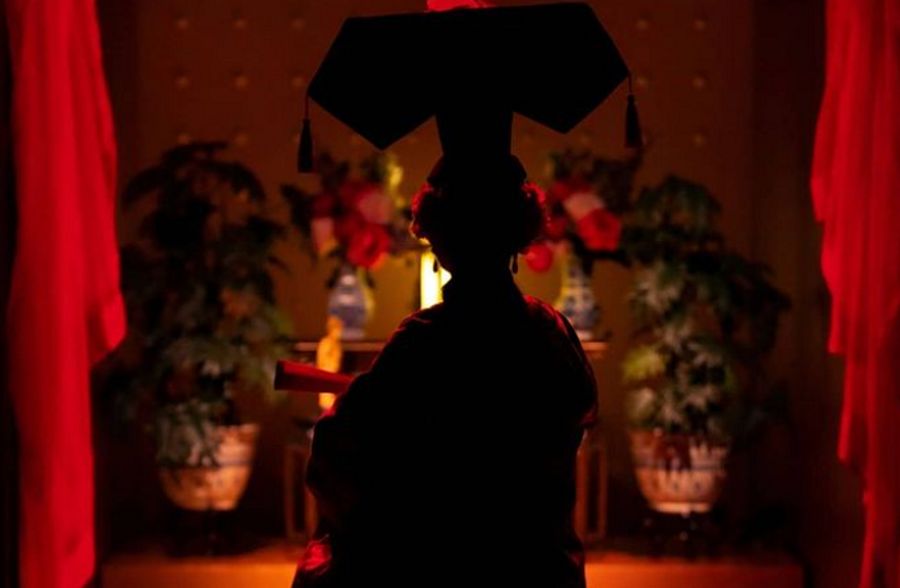Director Ralph Peña can clearly remember the day that his last in-person show, The Chinese Lady, shut down because of COVID-19. It was March 12, 2020, and this two-person play by Lloyd Suh (he/him) about the first Chinese woman to set foot in the United States had loaded into the second stage at Long Wharf Theatre in New Haven, Conn. It was the first day of tech rehearsal.
“They came out and said, ‘I’m sorry, we’re closing. The rest of the American theatre has decided to close on March 12,’” Peña recently recalled. “So we went home. And the show never opened.”
More than a year later, Long Wharf contacted Peña again and asked if he was interested in remounting The Chinese Lady as the first show to reopen the theatre’s in-person 2021-22 season. But this time, the play was not going to be on the second stage. It was going to be on the mainstage of the theatre, an upgrade from 204 seats to 408 seats. It is running there now through Oct. 31.
Other theatres had the same idea: Though TCG and American Theatre did not create an official Top 10 Plays list for the 2021-22 season, its data show that The Chinese Lady will be the most-produced play at TCG member theatres throughout the U.S. in the coming season, with productions at Portland’s Artists Rep, Philadelphia’s Interact Theatre, Ithaca, N.Y.’s Kitchen Theatre Co., Rochester, N.Y.’s Geva Theatre, and New York City’s Public Theater, in a co-production with its original mounter, Ma-Yi Theatre Company.
In a case of art imitating life, the play is based on the true story of Afong Moy, who traveled to the United States in 1834 when she was 14. Touted as allegedly the first Chinese woman to set foot in the U.S., she was displayed in a touring exhibition surrounded by paper lanterns, gold and red satin drapes, and Chinese paintings, furniture, and other decorative objects. The show was a way for white traders named Nathaniel and Frederick Carne to sell imported Chinese goods; patrons would pay to watch Moy eat, drink tea, and walk around on her bound feet, which were the source of perverse fascination. “I think the admission was, like, $.25, but for $1, she personally showed you her feet,” noted Peña.
Moy was put on display for eight hours a day, and communicated through a translator. She even met President Andrew Jackson. She later joined P.T. Barnum’s menagerie, and then in 1850, disappeared from the public record, when Barnum discarded and replaced her with another Chinese woman whose feet were even smaller (not a story you see in the revisionist film The Greatest Showman).
Almost 200 years ago, Moy toured around the country as an exotic oddity—local newspapers identified her variously as “Julia Foochee ching-chang king,” “Miss Ching-Chang-foo,” or “Miss Keo-O-Kwang King.” This coming season, Suh’s play about her life will be seen all over around the country, in different productions, with different actors playing Moy. But this time around, Moy will be telling her own story. She doesn’t need a translator to speak to the audience. She will speak for herself: about how she came to the U.S., what she finds strange about America, and how, maybe on this tour, there will be better understanding between Americans and Asians.
The play is more than a Wikipedia entry. It also tackles the notion of the white gaze: What does it mean to be looked upon by people who regard you as exotic? What does that do to you as a human being? How does it change how you act? How do we go beyond the surface to a deeper intimacy? And most crucially, can folks from different backgrounds ever truly understand each other?
Suh described being “haunted” when he first heard Moy’s story. “I feel protective of her,” he explained. “I feel this obligation to honor her. And so the idea of touring, the idea of going into different cities feels like an opportunity to do that.”
This time, when hundreds of thousands of people around the country look at Moy, they won’t see her as an object. Perhaps this time, white audiences will even see themselves in her, while Asian American audiences will see a piece of our collective history that has been buried. To Suh, the play is “giving her the opportunity to be seen in a different way. It’s my hope that at this particular moment, it will give all of us an opportunity to consider her legacy: what she meant to Asian America, what she meant to America, what she meant to the world.”
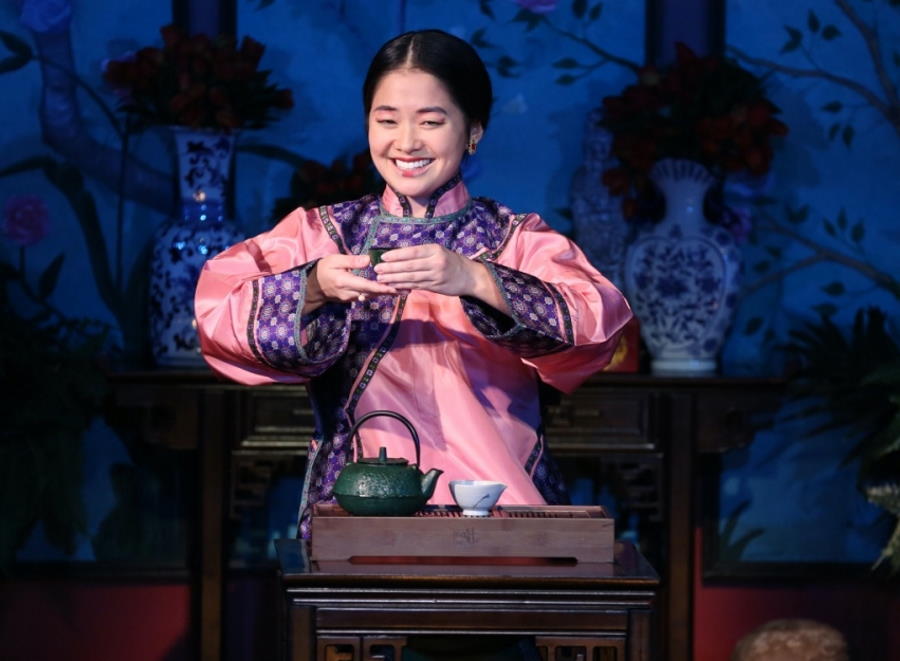
In New Haven, reconfiguring the play from a proscenium staging to a thrust hasn’t been easy. In the play’s world premiere at Barrington Stage, and in its subsequent Off-Broadway production, Peña staged it in a proscenium setting where Moy sat onstage in a box containing Chinese paraphernalia—a representation of what she would have looked like in the 19th century when she was displayed (think of those dioramas in the American Museum of Natural History, except significantly more racist).
That setting is not possible in a thrust configuration. For one, putting vases and lanterns around Moy would block the view for two sides of the audience. In the new staging, Moy is seated a bit removed from her Chinese diorama, on a bare stage.
A thrust staging also calls for more movement on the part of the actors. There’s one catch with that, as Peña explained, sitting in the lobby of the Long Wharf before a recent show. “Because the Chinese lady has bound feet, it’s not like she can walk everywhere. She’s seated for most of it. That’s the big challenge: With a person who’s supposed to be disabled, how do you move them around onstage?”
In the New Haven production, most of the physical movement is done by Jon Norman Schneider (he/him), who plays Atung, Moy’s translator. He makes sure to present the Chinese objects to all three sides of the audience in an Orientalist show-and-tell before handing them to Moy. Meanwhile, Moy herself addresses the audiences on all three sides of her. They’re small tweaks, but they demonstrate that the play can exist in multiple configurations. This new version even intensifies the sense of Moy as a zoo animal, with people peering at her from all sides—the oppressive white gaze is even more amplified.
For actor Shannon Tyo (she/her), who has played Moy since 2018, there’s another way in which the work has a new intensity, as a result of events since the onset of the COVID-19 pandemic. In one part of The Chinese Lady, Afong Moy talks about the recurring violence against Chinese people in the United States, including the time in 1871 when a mob descended upon L.A.’s Chinatown, lynching 20 Chinese Americans and injuring 52. When she says those lines now, there is an additional shudder of resonance, as attacks against Asians have notably increased during COVID-19, thanks to racist public figures associating the pandemic with China. Now audiences cannot dismiss the violence of white Americans against Asians as something sad that happened way back when—not while those violent attacks are still occurring with frightening frequency today. The show also lets audiences know that Asian people—and violence against them—have been present in America for centuries, and are an integral part of the American fabric.
“I feel like the audience is potentially more primed to receive the information from the characters involved because of the news lately,” Tyo said. “I feel like there’s an influx of interest in the history of Asian Americans, and potentially more of a willingness to listen to it, or to hold space for it.”
Peña agreed, attributing the fresh nationwide interest in The Chinese Lady to recent headlines and the #StopAsianHate campaign. He said he’s been getting phone calls “from theatres that have never paid any attention before” for recommendations for plays and actors, and invitations for him to come direct. “Asian American women died in Atlanta,” said Peña. “Suddenly there’s this focus on Asian Americans, anti-Asian violence, all of that stuff. So the response of the theatre community is to then say, ‘Okay, we’re going to include more Asian programming.’”
But when he gets those calls, Peña makes sure to ask those theatre leaders, “What are you doing after the show? And before the show? Because it can’t be a one-off, otherwise, I don’t want to work with you. What are you doing now to reach out to this community?”
Some theatres are actually committed to recurring programming, which is a positive sign, said Peña. But there are other theatres who, he said, are using Asian plays as a way to capitalize on a popular social conversation, and using Asian voices as a trend to sell tickets. Asian people become a convenient symbol of a theatre’s progressivism, of its commitment to diversity, of its relevance as an institution. Almost 200 years ago, Afong Moy was used as a symbol of “the Orient.” How do Asians go beyond being a symbol?
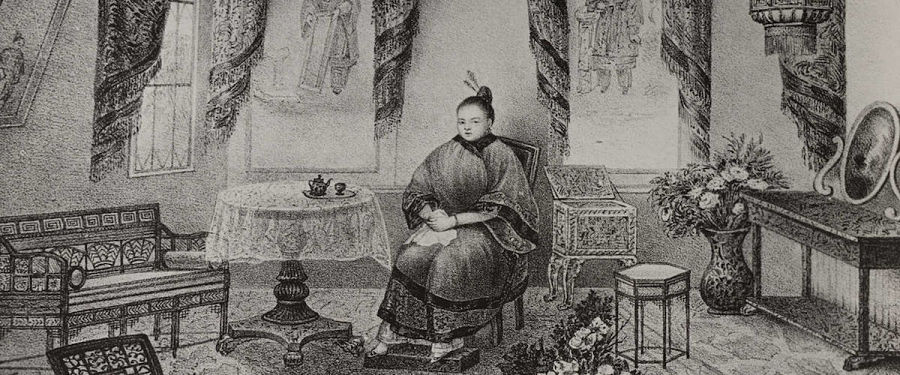
It was in Erika Lee’s book The Making of Asian America that I first read about Afong Moy. Moy wasn’t brought to America to help Americans understand the East. Instead, Lee wrote, “Afong Moy’s exhibit sent a clear message: China and the Chinese were exotic, different, and, as Moy’s bound feet further illustrated, degraded and inferior. By relegating her to an exotic curiosity, the Carne brothers and all who came to gawk at her reaffirmed the West’s superiority as well as the great differences between the United States and China.”
By looking at Moy, and other women of color like her (Sarah Baartman, whose exploitation was dramatized in Suzan-Lori Parks’s play Venus, or Julia Pastrana, also the subject of a play by Shaun Prendergast), white audiences could decry other cultures as barbaric and effectively absolve themselves of their own sins, including the genocide of Native Americans or, as Moy points out in The Chinese Lady, the transatlantic slave trade.
When other people use you as a way to look at themselves, your own reflection will become blurred and fractured. You may even start to hate that reflection. The image that Moy presented to white Americans about Chinese people (and by extension, all Asians) persists to this day: Quiet and submissive. Foreign and exotic. Dirty and diseased.
Some of those stereotypes were unfairly placed upon Asian Americans. Other stereotypes were performed by Asian Americans as a means of survival: The prostitute from Full Metal Jacket and Long Duk Dong from Sixteen Candles were played by Asian actors, after all. We have both pushed against the confines placed upon us and sometimes played into them.
Moy inhabits that contradiction. She begins The Chinese Lady by performing her ethnicity for the audience. In real life, this is how she made her living. Yet the play version of Moy is not just exploiting her culture for money, nor is she a victim. She is trying to be a representative, an ambassador for Chinese culture. As she tells President Andrew Jackson in the play: “I feel my fame has provided me a tremendous opportunity to share more about who we are; not simply on the surface levels of clothing and adornments, but a deeper, more lasting intimacy. Through such proximity and visibility, we might be able to share the very best parts of Chinese culture and American culture with one another, in pursuit of greater empathy and commonality.”
Her passionate entreaty is simplified in translation into: “I am famous. I want you to know who I am. Become close… um, yes. We become close. We become more the same.”
This is the only instance of Atung actually translating for Moy, showing how butchered translations have historically relegated non-English speakers to being seen as backward and uneducated. It also shows the limits to language itself, and the difficulty for people from different backgrounds to truly understand each other, especially when one party already assumes the other party is inferior. But are understanding and intimacy truly possible?
Especially when it comes to Asian Americans, can it be possible to understand something so wide and so varied? Asian America has always been an amorphous term, encompassing the diaspora of 48 countries. It also contains those who have been in America for multiple generations and have attained some privilege, alongside new immigrants working in low-wage jobs, who are at the most risk of violence. For prior generations, being an Asian American meant assimilation: speaking “perfect” English, to the point where you sacrificed the language of your ancestors, or gave up your given name for a Western one that was easier to pronounce and were thus able to disappear into majority white spaces.
Depending on where you grew up in America, being Asian American also meant feeling shame: at the food that your mom packed for you, of your eyes, of the color of your skin. And it meant having to choose between America or Asia. When you are asked, “Where are you really from?”, the feeling that question brings is one of allegiance: Of course I am from here, how dare you think I was a foreigner from over there.
For so long, being Asian American meant privileging the American part of that descriptor, subsuming the Eastern parts of yourself for the Western parts, which were deemed superior. It meant separating yourself from your diasporic community, and their pressing concerns around poverty, incarceration, deportation, and healthcare, and entering the upper ladders of society, which were inevitably Western. You give away your community to ascend, and then wonder why there isn’t anyone who looks like you when you get to the top.
I now wonder if that sacrifice is itself an act of white supremacy.
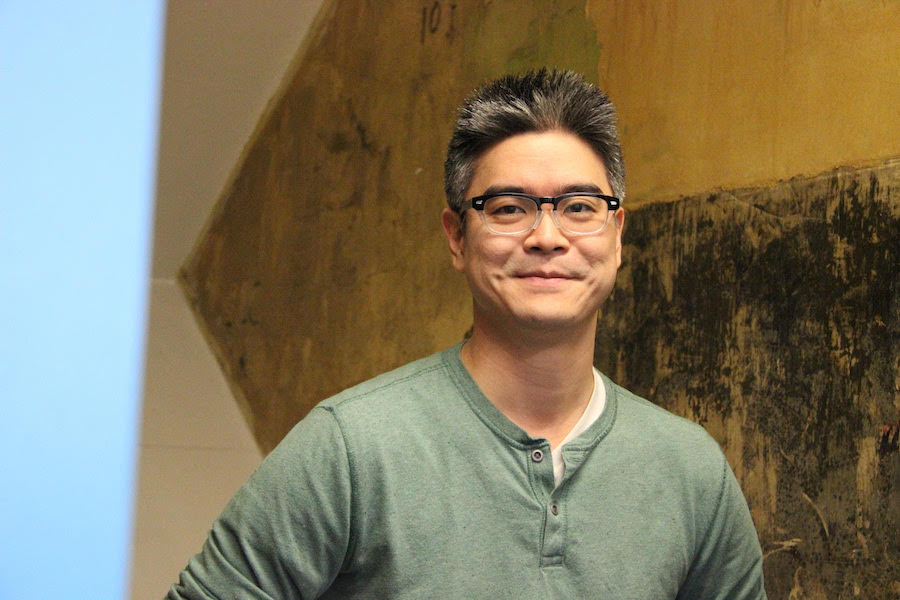
Our parents and grandparents were foreigners, and proudly so, as was Afong Moy. That did not mean they were less smart, or less worthy of being seen as human. That was part of why Suh chose to reframe Moy’s story not as one about an exploited victim, but one where she made the best out of limited circumstances. She was not ashamed of her culture. She was happy to showcase it. She did not think Western culture is better, but she did love her bread and mashed potatoes.
“I’m also not that interested in victimhood,” said Suh. “So much of what we read, a lot of that Asian American scholarship—it’s not fun to think about a legacy of shame and victimhood. For us, for you and I, and for the generations in the future, we need to start thinking about, what can we do with that? It’s not just showing scars, or a list of grievances. What can we do with it? What can we build from it that disrupts that legacy of shame?”
If we are to dismantle the white gaze, we first must dismantle it within ourselves.
What if Asian America was something different—something that is not restricted by place, or by how many languages you speak or how well you speak them, or how you dress? What if we tried to stop putting ourselves into boxes created by other people, stop trying to fit into other people’s definition of what Asian is, and allowed the term Asian America itself to be diverse in definition and global in scope? In that vastness, Asian America could thus be even more splendid.
I spoke earlier this year to Steven Yeun, who played a Korean man newly immigrated to America in the fiilm Minari. His character, Jacob, spoke Korean for almost the entire movie and when he spoke in English, it was heavily accented. In the past, Jacob might have been a subject of ridicule from white audiences and a source of embarrassment in Asian ones. But this time, an Asian man with a heavy accent was seen by audiences and critics as fully human, because he made us see the world through his eyes. He owned his story.
Yeun gave me a definition of Asian America: “It’s really just a confidence in our own existence,” he said. “I think, oftentimes, because we only have the parameters of Korea (or Asia, or a mother country) and America, we have to pick a side and pick little bits and pieces to help us find ourselves. And while that can work, it often ends up sounding like I have a foot in both. And the truth is I don’t have a foot in both. I just have a foot in my own thing—our own intrinsic third culture.”
The predominant narrative of Asian America, then, should not be shame but reclamation. It should not be America-focused. It should contain the world. That requires us to stop performing, stop playing into the expectations that we must fit into a box or a standard definition.
If the goal of a stereotype is to flatten, to be seen as human we must advocate for our complexity.
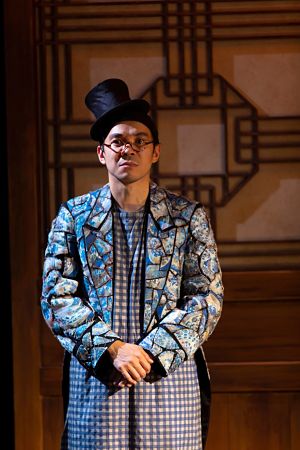
Schneider has performed in two productions of The Chinese Lady as Atung: one before the pandemic at Milwaukee Rep, and now at Long Wharf. He is aware that a majority of the audiences who come to see The Chinese Lady are white. But there’s been a shift for Schneider in how he chooses to perform for those audiences. Whereas before he was concerned about how they might read his performance, and whether they would see him as a stereotype or actually understand the play, these days he is less worried about that white gaze.
“I think the older I get, the more I try to just trust in the story, and the production and the storytelling,” Schneider said. “Because I know that I can’t control how the audience receives something. And I know what my intention is, what the intention of the production is, and what the intention of the cast of actors is. And I can only put my faith in that and try to tell the story as clearly and articulately as I can.” He added, “And if some people don’t get it, then they don’t get it…So yeah, I’m trying to disabuse myself of that responsibility.”
“Hear hear,” chimed in Tyo.
Nowhere is that confidence more clear in The Chinese Lady than at the end of the play. Spoiler alert: The ending fast-forwards to the present day. Moy is still here, still trying to create understanding between two cultures, saying, “If we take the time to really look at each other. To really look at each other. Then we might see, through all that vastness and variance, something true and real and wonderful. It is a beautiful thing to look at something long enough to really understand it. But it is so much more beautiful to be looked at long enough to be understood.”
In the Long Wharf version, Moy delivers this ending monologue while finally stepping off the platform where she had been on display for the entire play. She is no longer performing, and no longer in a box. As Tyo put it, when she delivered that ending monologue before, “I used to deliver in a way that I thought the audience wanted me to say it. And now I deliver it in the way that I want to say it.” In other words: The white gaze is no longer affecting her performance.
For the actors, the show has become an act of reclamation. By the end, the performance has ceased, and now they—and we—can truly be honest, and truly see each other.
Suh characterized the end of the play as “a moment of redemption, of taking something back, of owning something for oneself.” And when Moy can own her voice and her image, and speak to the audience as her true self, said Suh, “her redemption can be ours, as well.”
Diep Tran (she/her) is the former senior editor of this magazine. She is currently a contributor for Backstage, The Undefeated, NBC Asian America, New York Theatre Guide, and other publications. Follow her on Twitter @DiepThought.
Creative credits for production photos: For the Long Wharf production and returning for the 2022 production with the Public Theater: direction by Ralph Peña, lighting design by Jiyoun Chang, costume design by Linda Cho, sound design and music by Fabian Obispo, scenic design by Junghyun Georgia Lee; for the 2018 Ma-Yi production, direction by Ralph Peña, scenic and costume design by Junghyun Georgia Lee, lighting design by Oliver Wason, and sound design and music by Fabian Obispo.

